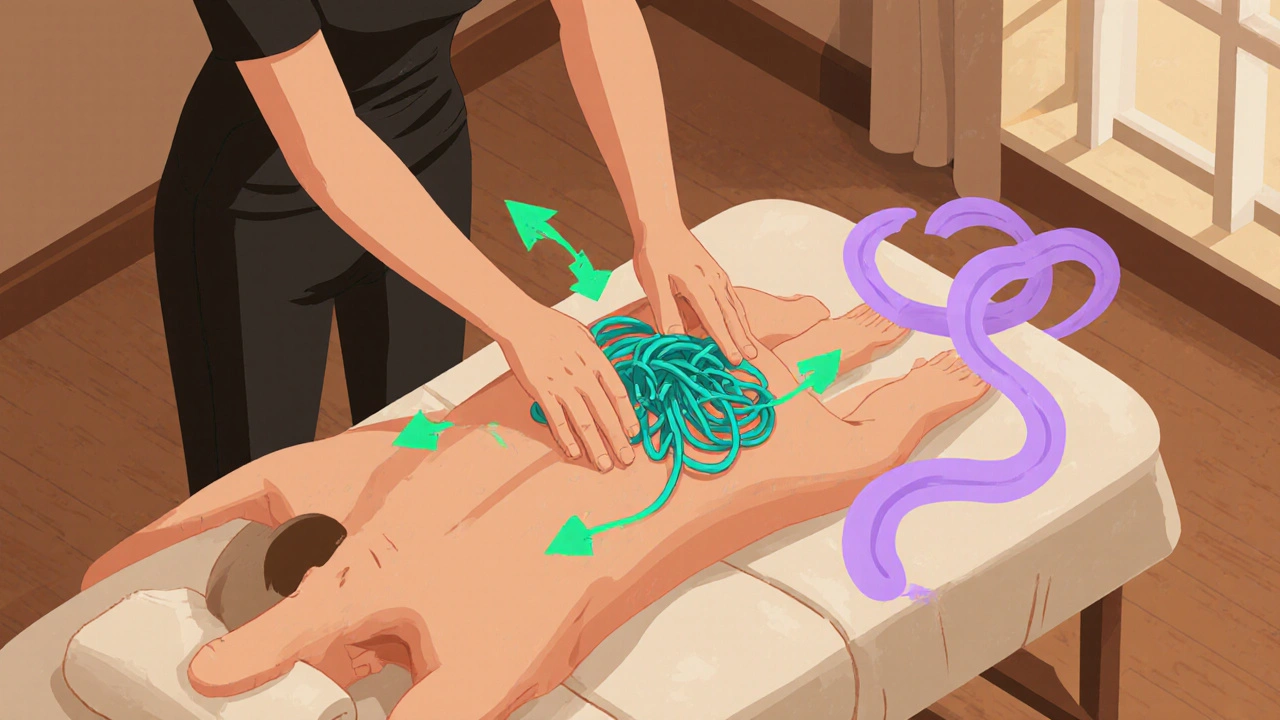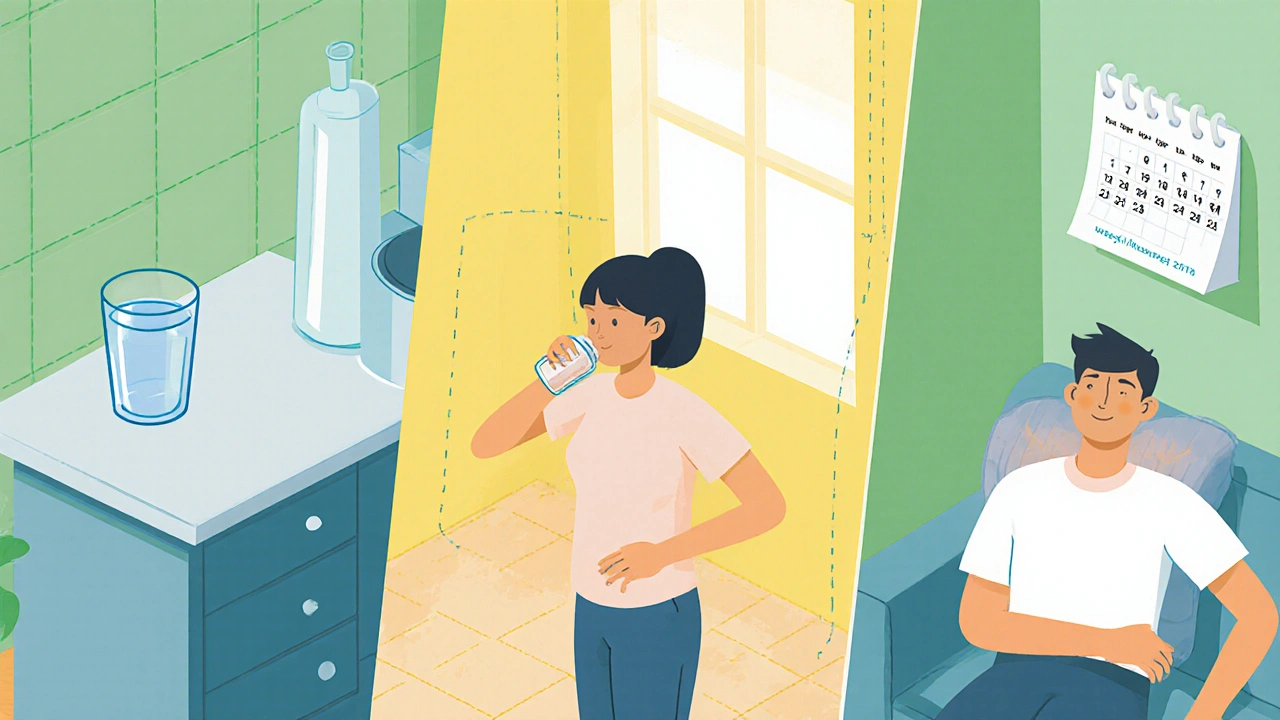Massage Technique Selector
Get personalized recommendations for the most effective massage therapy based on your symptoms and lifestyle.
Tell us about your spasms
Your Recommended Technique
Aftercare Tips
Ever felt a sudden knot in your back that just won’t let go? That’s a muscle spasm screaming for attention, and there’s a surprisingly simple way to quiet it down: massage therapy. Below we’ll break down why hands‑on treatment works, which techniques target the tightest spots, and how to turn a single session into lasting freedom.
What a Muscle Spasm Actually Is
Muscle spasm is a sudden, involuntary contraction of muscle fibers that creates a hard, painful knot. It often stems from over‑use, dehydration, or poor posture, and the body’s alarm system can keep it firing for minutes or even days. The pain isn’t just a nuisance; chronic spasms can limit mobility, disrupt sleep, and elevate stress hormones like cortisol, which in turn fuels more tension. Understanding the biology helps us see why a skilled touch can reset the system.
How Massage Therapy Counters the Spasm Cycle
When a therapist applies pressure, several things happen at once:
- Mechanical pressure stretches the muscle fibers, encouraging them to return to a relaxed length.
- Massage stimulates blood flow, delivering oxygen and flushing out metabolic waste that irritates nerves.
- Touch triggers the release of endorphins and serotonin, natural pain‑killers that lower the perception of discomfort.
- The nervous system receives a calming signal, reducing the firing of the motor neurons that keep the spasm locked.
In short, massage hits the spasm from the inside out, breaking the feedback loop that keeps it alive.
Top Techniques for Tackling Spasms
Not all massages are created equal. Below is a quick guide to the most effective styles when dealing with stubborn knots.
| Technique | Depth of Pressure | Primary Target | Best For |
|---|---|---|---|
| Swedish Massage | Light to medium | Superficial muscles & circulation | Gentle relief, stress reduction |
| Deep Tissue Massage | Medium to firm | Deep muscle layers & fascia | Chronic knots, tight hamstrings |
| Myofascial Release | Variable, sustained pressure | Fascial adhesions | Repetitive strain, limited range |
| Trigger Point Therapy | Firm, focused | Specific hyperirritable spots | Localized spasms, radiating pain |
For most people dealing with acute spasms, a session that blends deep tissue and trigger point work hits the sweet spot. If you’re new to massage, start with Swedish to ease tension before moving deeper.
What to Expect During a Session
- Assessment: Your therapist will ask about the spasm’s onset, aggravating activities, and any medical conditions.
- Positioning: You’ll lie on a comfortable table, often draped with a sheet to keep things private.
- Warm‑up strokes: Light gliding motions get blood moving and prepare the tissue.
- Targeted work: The therapist applies sustained pressure on the knot, usually for 30‑90 seconds, then releases.
- Stretch & feedback: Gentle stretching follows each pressure point, and you’re encouraged to communicate comfort levels.
Most people notice a reduction in pain within the session, and the muscle feels looser afterward. A lingering soreness is normal-think of it as a workout recovery.
DIY After‑Care: Keep the Relief Rolling
Massage gives you a fresh start, but the benefits last longer when you add a few home habits:
- Hydrate: Water carries nutrients that help muscles heal. Aim for at least 2 liters on massage days.
- Gentle stretching: A 5‑minute routine targeting the treated area prevents the fibers from snapping back into tension.
- Heat therapy: A warm shower or heating pad for 10 minutes relaxes residual tightness.
- Movement breaks: If you sit for long periods, stand up and roll your shoulders every hour.
These steps reinforce the circulatory boost and endorphin surge you got from the session, turning a one‑time fix into a lifestyle habit.

When Massage Might Not Be Enough
While massage is powerful, there are scenarios where you’ll need additional support:
- Neurological disorders: Conditions like multiple sclerosis can cause spasms that require medication.
- Severe injury: A torn muscle may need physiotherapy, rest, and possibly imaging before massage.
- Infection or skin issues: Open wounds or cellulitis call for medical attention first.
Talk to a qualified physical therapist or your doctor if any of these red flags appear. In many cases, a combined plan-massage plus targeted exercises-delivers the quickest relief.
How Often Should You Book?
Frequency depends on spasm severity and your goals:
- Acute spasms: 2‑3 sessions per week for the first two weeks can break the cycle fast.
- Chronic tension: Weekly maintenance keeps muscles supple and prevents flare‑ups.
- Pre‑event prep: Athletes often schedule a deep tissue session 48 hours before a competition to prime the muscles.
Pay attention to how your body feels after each visit. If pain returns quickly, you may need to adjust technique, pressure, or add complementary stretching.
Choosing the Right Therapist
Not every practitioner is a spasm‑specialist. Look for these credentials and traits:
- Certification from a recognized massage school (e.g., AMTA, EME).
- Experience with sports or rehabilitative massage.
- Willingness to discuss your medical history and adapt pressure.
- Positive client reviews mentioning relief from muscle knots.
A good therapist will treat you like a puzzle, not a one‑size‑fits‑all.
Bottom Line: Why Massage Therapy Wins for Muscle Spasms
Massage directly attacks the root causes of a spasm-poor circulation, nervous system over‑activity, and trapped fascia-while also delivering a wave of feel‑good chemicals that dull pain. It’s non‑invasive, drug‑free, and adaptable to almost any lifestyle. Pair a skilled session with simple after‑care, and you’ll turn those dreaded knots into a thing of the past.

Can massage replace medication for muscle spasms?
Massage can reduce the need for painkillers in many cases, especially for mild to moderate spasms. However, it isn’t a complete substitute for prescription muscle relaxants when the spasms are severe or linked to a medical condition. Always consult a doctor before stopping any medication.
What’s the difference between deep tissue and myofascial release?
Deep tissue focuses on breaking down tight muscle fibers through firm pressure, while myofascial release targets the connective tissue sheath (fascia) with slower, sustained stretches. Both can help spasms, but myofascial release is better for adhesion‑related restrictions.
How long should a typical spasm‑relief session last?
A focused session usually runs 45‑60 minutes, giving enough time for assessment, warm‑up, targeted pressure, and post‑massage stretching.
Is it safe to get a massage if I have a recent injury?
Not always. If the injury involves swelling, tears, or acute inflammation, massage might worsen it. A qualified physical therapist should clear the area first.
Can I combine massage with home exercises?
Absolutely. In fact, therapists often prescribe specific stretches or strengthening moves to keep the muscle balanced after a session, maximizing long‑term relief.
Rachel Valderrama
October 21, 2025 AT 14:44Oh, sure, just because you get a good squeeze, your muscles will magically never spasm again. But hey, who needs science when you have a therapist’s hands?
Chirag Muthoo
October 21, 2025 AT 16:07While the benefits outlined are noteworthy, it remains essential to integrate these interventions within a comprehensive therapeutic regimen, ensuring that any underlying pathology is addressed prior to commencement.
Angela Koulouris
October 21, 2025 AT 17:31Think of each session as a gentle reboot for your body, a chance to untangle those stubborn knots and let your muscles breathe again.
Harry Bhullar
October 21, 2025 AT 18:54When you step onto the massage table the first thing you notice is the deliberate cadence of the therapist’s strokes, a rhythm that signals to your nervous system that it’s time to relax.
That rhythmic pressure not only stretches the contracted sarcomeres but also encourages the surrounding fascia to release its grip on the tissue.
Increased blood flow follows, delivering oxygen and flushing metabolic by‑products that would otherwise irritate nociceptors and perpetuate the spasm cycle.
Simultaneously, mechanoreceptors are activated, sending afferent signals that compete with pain signals at the spinal cord level, a phenomenon known as gate control.
The brain responds by releasing endogenous opioids such as endorphins, which further dampen the perception of pain.
Moreover, serotonin levels rise, promoting a sense of well‑being and reducing the stress hormones that can trigger additional tension.
From a practical standpoint, a therapist often begins with broad, gliding strokes to warm the area before zeroing in on the palpable knot.
Once the target is located, sustained pressure is applied for roughly thirty to ninety seconds, a duration sufficient to remodel the muscle spindle’s firing pattern.
After the pressure is released, gentle stretching is incorporated, reinforcing the newly lengthened muscle fibers and encouraging proper alignment.
It is advisable to follow up the session with hydration, as water assists in transporting the cleared metabolic waste out of the tissue.
Light dynamic stretching for five minutes can maintain the gains, while a warm shower the evening after helps to solidify the relaxed state.
If you notice residual soreness, treat it as you would a light workout – a sign that you have challenged the tissue appropriately.
Consistency is key; two to three sessions per week for the initial two weeks can break the chronic cycle, after which a maintenance schedule of weekly visits often suffices.
Always communicate openly with your therapist about pressure tolerance, as an overly aggressive approach can provoke reflexive tightening rather than relief.
In summary, the combination of mechanical, circulatory, and neurochemical effects creates a synergistic environment that not only alleviates the immediate spasm but also reduces the likelihood of future flare‑ups.
Dana Yonce
October 21, 2025 AT 20:17Hydration is key, drink up! 😊
Lolita Gaela
October 21, 2025 AT 21:41Therapeutic myofascial modulation induces mechanotransduction pathways that attenuate nociceptive sensitization, thereby optimizing sarcoplasmic calcium handling. Additionally, the viscoelastic remodeling of the fascial network improves proprioceptive feedback, which curtails hyperactive motor unit firing.
Giusto Madison
October 21, 2025 AT 23:04If you think a single Swedish rub will fix a chronic spasm, you’re deluding yourself – demand real pressure or you’re wasting time.
Jasmina Redzepovic
October 22, 2025 AT 00:27Only in America do we have therapists trained to actually understand biopsychosocial models; other countries just slap oil on it and call it a day.
Eli Soler Caralt
October 22, 2025 AT 01:51Ah, the fleeting dance of fascia and consciousness, a veritable symphony of tension and release – one might say it is the corporal echo of Nietzsche’s will to power. 🌌 It’s a reminder that your body recieves the same poetic cadence as the universe itself.
Eryn Wells
October 22, 2025 AT 03:14Your poetic spin reminds us all that self‑care transcends borders – a warm hug for every body, wherever you are! 🌍🤗
Kathrynne Krause
October 22, 2025 AT 04:37Let’s keep the conversation buzzing with tips, stories, and that unstoppable energy that fuels our journey to a knot‑free life!